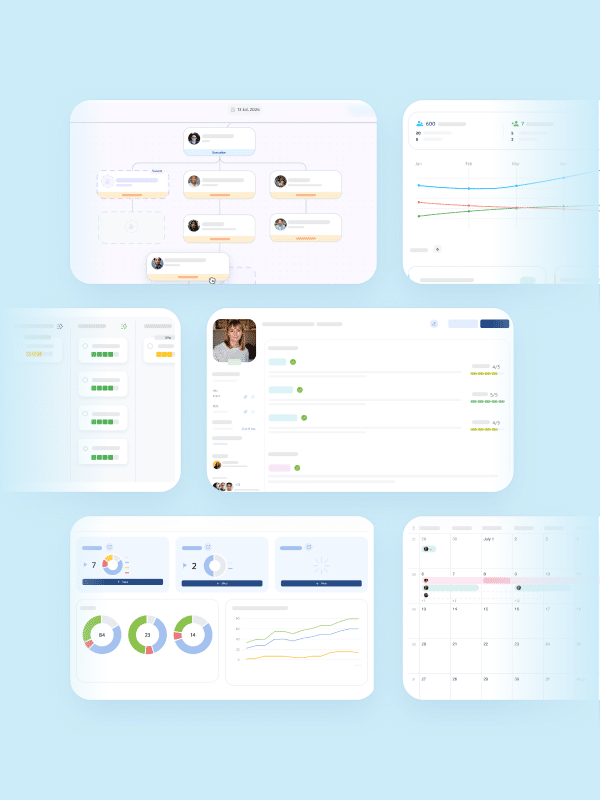In the digital age, HR operations are increasingly data-driven. This convenience, however, raises concerns about the potential exposure of sensitive HR information through colleagues’ actions. In this article, we address vital questions regarding the security of this data and explore strategies to protect it. Join us as we navigate the challenges of preserving sensitive information in the digital HR landscape.
Digitalization can involve risk exposure through colleagues…
Technology is more present in HR than ever before, and we have become accustomed to digitally sharing and storing personal and relevant information in our operations. This can include everything from personal data and salaries to health information and work performance. Risk exposure being a highly relevant issue is not surprising, especially given the increased demand for data protection and privacy. There are possible risks associated with increased digitalization where colleagues can cause data exposure through their daily digital activities.
To clarify this and what we can do about it, we have chosen to focus on two core questions:
- How secure is the sensitive information we store as employers?
- How can we safely collect and protect our employees’ sensitive, private, and confidential information?
But before we delve into these two questions in more detail, let’s take a closer look at what “risk exposure through colleagues” actually means.
Risk exposure through colleagues is about employees in a company accidentally or, more rarely, intentionally exposing sensitive information, with the risk that it ends up in the wrong hands or is used in a way that could harm the company or its employees. It’s as if someone in your workgroup unintentionally shares something private or important with the wrong person. In other words, it’s about the risk that colleagues, for various reasons, can cause different types of problems for the company through their actions, and we who work in the organization need to be aware of and carefully manage these risks to avoid harm or issues.
Risk exposure in the context of data and digitalization refers to the vulnerability or uncertainty that a business face when handling digital data and processes. But how does this manifest in reality?

Reflections from the CEO
At Heartpace we have security at heart and we’ve manifested this through becoming ISO 27001 certified. Data security should be a top priority for all HR departments!
Sensitive data exposure in HR systems: risks from colleagues’ digital activities
Colleagues can cause data exposure through their digital activities in various ways when it comes to using an HR system where sensitive personal information is stored and managed. Here are some concrete examples of how this can happen:
- Accidental sharing of login credentials: An employee may accidentally share their login credentials (username and password) with another colleague. This colleague can then use these credentials to access the HR system and potentially change, delete, or expose sensitive personal information.
- Unauthorized access to workstations: If an employee leaves their workstation unlocked and unattended, another colleague may gain access to the computer and potentially open the HR system. This can lead to the exposure of sensitive information.
- Mishandling of emails: An employee may send email messages with attached files containing sensitive HR information to the wrong recipients. If the email reaches a colleague who should not have access to the information, this can lead to data exposure.
- Incorrect data transfer: During data transfers between HR systems and other systems, an employee may accidentally send information to the wrong recipient or use incorrect settings, resulting in information exposure.
To minimize the risk of such incidents, it is important to have strong security measures in place, including password policies, access controls, security training, and system activity monitoring. So, how secure is the data we store?
How secure is the sensitive information we store as employers?
The security of sensitive information that we, as employers, store digitally varies depending on several factors. It primarily involves the company’s data protection practices, technological measures, and employees’ awareness of security. Let’s take a closer look at various factors that affect the security of sensitive stored information.
- Data protection regulations and compliance: In Sweden, we have data protection regulations that govern how we, as employers, should handle and protect the sensitive information we collect from our employees. Compliance with these regulations is a fundamental aspect of ensuring the security of information.
- Various technological security measures: We can use various technical measures such as encryption, firewalls, and access controls to protect digital information. This helps ensure that sensitive information is well protected against unauthorized access. This is particularly important considering the increased digitalization and the potential risks that come with it, especially when many people handle sensitive data.
- User education: An important part of security is educating employees on best practices for data security. This can involve using strong passwords, being cautious about opening unknown email attachments and reporting any security incidents. But it also involves raising awareness that when many people handle sensitive data, each individual’s responsibility is crucial for maintaining a secure digital work environment. It is a collective effort where everyone needs to be involved together to protect sensitive, private, and confidential information from being exposed.
- Incident management: Even with preventive measures, security incidents can occur. Therefore, it is important to have a plan to handle these types of incidents and thus minimize potential issues if they occur. In short, an incident management plan is a prepared strategy that follows step-by-step actions to identify, isolate, analyze, and resolve security incidents. A concrete plan helps minimize impact, restore normal operations, and prevent similar events in the future.
The security of digitally stored sensitive information depends on several factors, as mentioned. First, we have data protection regulations, which can be seen as rules for how to handle our valuable secrets. Then we have various technical tricks like encryption and firewalls, which act as effective defenders protecting digital information. User education is about providing everyone with knowledge on how to keep secrets safe. Finally, if something goes wrong, we need a good plan to address the problems. The last core question revolves around how we can securely collect and protect our employees’ information.

Browse our webinar library!
We have a number of webinars about different HR related topics available to watch whenever you want.
How can we safely collect and protect our employees’ sensitive, private, and confidential information?
With a secure HR system, the risk of sensitive information falling into the wrong hands is minimized. A well-developed HR system is designed to protect and manage the extensive amount of sensitive information that an employer handles, including personal data, salaries, performance, and much more.
A well-developed HR system uses advanced technology, including encryption and access controls, to ensure that only authorized personnel can access said information. This provides an additional level of security that is difficult to achieve with manual information handling.
With an HR system, it is also easy for employers to more effectively comply with data protection regulations, as the system is designed to operate following these regulations and automatically manage compliance.
In this context, it is important to remember that even with a secure HR system, human behavior is a critical factor. Even with the most sophisticated technological security measures, the human factor remains the biggest risk for data exposure. That’s why user education and awareness of security practices are crucial to ensure that information is not accidentally exposed. By combining the HR system with security-conscious and risk-aware users, you as an employer can confidently manage and protect the sensitive information you have about your employees.
In conclusion
We hope that this article has provided you with an overview of the challenges and solutions surrounding the security of digitally stored sensitive information within HR. Digitalization has changed how we collect and manage data and with that, new risks have emerged. With a deeper understanding of the concept of “risk exposure” and the factors affecting HR security, we intend to provide you with more tools to address these challenges head-on.
If you would like more information on how to securely manage and protect your organization’s sensitive, private, and confidential information, or if you are interested in implementing a secure HR system, please do not hesitate to contact us. We are available to support you in safely navigating the digital era and maintaining the integrity of both your organization and your employees.
If you are looking for a solution that provides these opportunities and benefits, you are warmly welcome to contact us to schedule a demo of the Heartpace HR System!

Do you want to see more?
Book a demo here to see Heartpace HR system
Explore more posts
Want to keep updated?
Subscribe to our blog posts, news and webinars here. We promise that we won’t overwhelm you with emails, nor will we never ever give your email address to anyone else!








